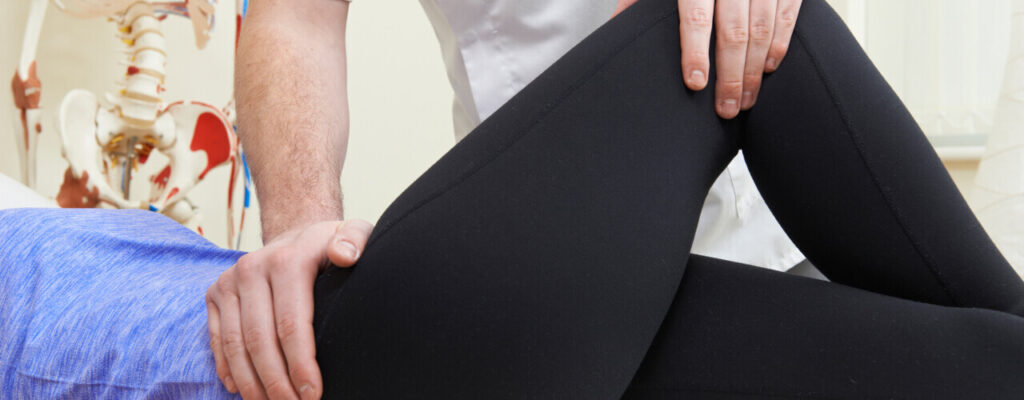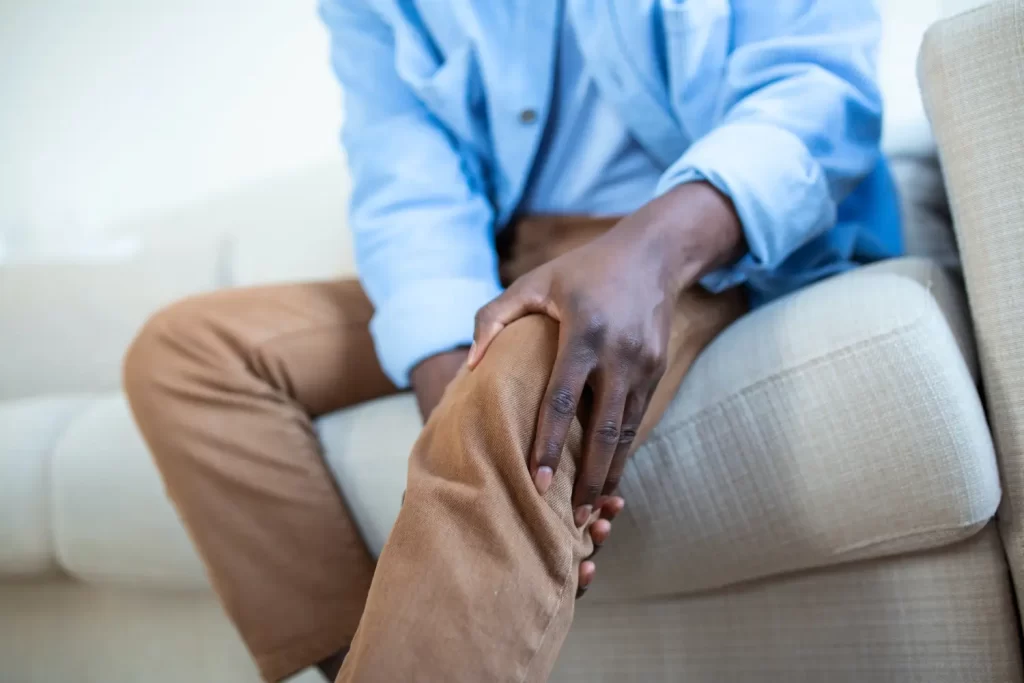A Simple Guide to Hip and Knee Pain Relief

Move with Ease Once Again!
Are you struggling with debilitating or uncomfortable pain in your knees or hips? If so, physiotherapy can help.
The knees and hips are important, complex areas of the body. There are several tendons, joints, and muscles that are joined together in these parts of your body, and they help you to move in normal ways.
However, if these areas are damaged at all, or if you’re feeling pain in them, it can become very difficult to do the things you normally do.
Thankfully, physiotherapy can help relieve knee and hip pain! Our innovative care strategies at Lake Country Physiotherapy will help you find quick relief. Call our office to learn more about how a trained physiotherapist can help give you the long lasting pain relief you deserve.
Common Conditions That Cause Hip and Knee Pain
There are many kinds of conditions that can negatively affect the movement of your knees and hips.
These issues occur because of traumatic injury, chronic disease, or repetitive motions you do with a job, sport, or hobby.
- Core Muscle Injury — Notice a pain in your groin area after a weekend of playing ball with your pals? If so, you may be suffering from a core muscle injury, like a strain or tear of the muscles and soft tissues in your lower abdomen area. Rest can help this common injury, but we recommend scheduling an appointment with our physiotherapist if the hip pain lasts for several days to a week or more.
- “Runner’s knee” – An unstable kneecap can lead to chronic knee pain. This condition is known as patellofemoral syndrome or “runner’s knee.”
- Bursitis — If you notice recurring pain on the outside of your hip, buttocks, or thigh, there’s a good chance that you have bursitis or inflammation of the cushioning pillow-like sacs that work to keep your tendons from rubbing against your bone. This is a common condition as we age and can be relieved with targeted physiotherapy treatments.
- Strains, sprains, and ruptures – The knee and hip joints can move thanks to muscles, tendons and ligaments. Repetitive motion or acute injuries can cause a strain (damage to muscles or tendons) or a sprain (hyperextension of a ligament). Athletes are vulnerable to ruptures of the ACL (anterior cruciate ligament).
- Fractures — The bones of the knee can easily be broken during a fall, car accident or sporting accident. The risk of suffering a knee fracture increases as we age, as many older adults develop osteoporosis which weakens the bones. Physiotherapy can help to reduce pain and inflammation after a fracture and increase mobility over time.
- Osteoarthritis – Osteoarthritis is a degeneration of the cartilage that normally keeps the bone ends in a joint from rubbing together. The resulting friction causes chronic pain and inflammation.
- Torn Meniscus — The meniscus is a tough, rubbery piece of cartilage that works as a shock absorber in the thigh bone and shinbone area. If you suddenly twist your knee while playing sports or attempting other strenuous moves, the meniscus can be torn, causing intense and long-lasting pain. Regular visits with our physiotherapist can help to reduce your symptoms.

5 Reasons You Should Consider Physiotherapy For Hip And Knee Pain
1. Move with ease and without pain
Many of the impairments you and your physiotherapist work to correct—including weakness, poor posture, and limited range of motion—may have been caused or worsened by things you’re unknowingly doing.
This includes sitting too much, using poor body mechanics, breathing improperly, and having an ineffective ergonomic set-up at work. A physiotherapist can educate you about ways to move in more energy-efficient and safe ways to enhance the overall effects of your care and reduce the risk of re-injury.
2. Improve the health and fitness of your joints
When you see a physiotherapist for hip or knee pain, he or she may use joint mobilizations or manipulations to help promote healing and attract circulation to the inner joint surfaces.
These techniques have also been shown to reduce pain and improve joint alignment…and they feel good, too! When complemented with services like massage and the Active Release Technique, physiotherapy can help you get physical and mental relief.
3. Participate in treatment methods that are safe, effective, and non-invasive
You don’t have to rely on over-the-counter or prescription painkillers to ease those achy, stiff, swollen joints!
Physiotherapy modalities that have been shown to ease pain, reduce spasms, increase circulation, and promote healing include electrical stimulation, diathermy, cold laser therapy, dry needling, and therapeutic ultrasound.
4. Enhance your range of motion and improve your joint strength
Increasing muscle strength and mobility of the connective tissues around your joints (including the tendons, muscles, fascia, and joint capsules) will help your joints feel better and move better.
This can also help you improve your functional activity tolerance, which is essential for work, leisure, and simple daily function.
5. Reclaim your life!
According to the Arthritis Foundation, exercise is one of the best ways to manage hip pain and knee pain caused by osteoarthritis.
By implementing some or all of the above interventions in a customized treatment plan, a physiotherapist can help you get back to regular exercise in a way that is safe and effective for you, based on your current abilities, goals, and needs.
This is especially helpful if you’re currently on a fat loss journey since being overweight is a major risk factor for knee and hip pain.
What To Expect From Physiotherapy for Your Hip and Knee Pain
Your pain might feel overwhelming, but no matter what condition you’re suffering from, a physiotherapist can help relieve your pain.
Your movement specialist will assess your condition, medical history, and pain levels to create a specialized program that meets your exact needs.
Read on to learn more about treatment methods a physiotherapist might use to reduce and relieve hip and knee pain.
- At-Home Exercises – Did you know you don’t always have to be in a clinical setting to do physiotherapy exercises? It’s true! Physiotherapy techniques can be incorporated into a home exercise program that can become part of your daily routine.
- Ice & Heat – A physiotherapist may use ice packs to reduce swelling and inflammation. Heat is also commonly used during physiotherapy to help increase mobility and reduce pain.
- Manual Physiotherapy – Hands-on techniques are used often in physiotherapy to reduce pain in your hips and knees. This could include stretching exercises or a variety of massage techniques.
- Laser Therapy – Laser therapy has become much more popular in physiotherapy for pain management. It can help improve the growth and reproduction of cells, increase circulation, and also reduce inflammation.
- Ultrasound Therapy – Ultrasound therapy can be used in physiotherapy to provide soothing heat to deep tissues. A licensed physiotherapist can also utilize ultrasound technology to easily identify specific areas of pain.
Don’t let yourself live in pain any longer!
Ready to get started on the path toward relief? Find out today how physiotherapy can reduce or even eliminate your knee or hip pain.
Your physiotherapist can conduct a thorough examination of your body, pinpoint the areas in your hips and knees where you’re struggling with pain, and create a customized program to treat your particular condition.
You deserve to get back to the activities you love without feeling as if your hips and knees will limit you. You can find relief with one of our highly experienced physiotherapists, so what are you waiting for?
Contact Lake Country Physiotherapy to schedule your one-on-one evaluation today, and get back on the road to recovery.
Sources:
- https://www.moveforwardpt.com/SymptomsConditionsDetail.aspx?cid=3cc6f3b1-0752-4f40-a09c-bb9e33d4d813
- https://www.moveforwardpt.com/Benefits/Default.aspx
